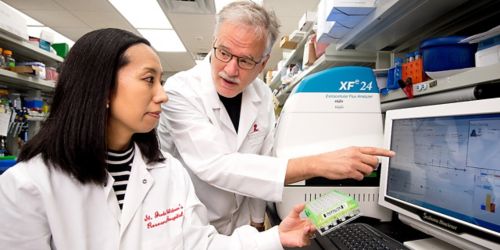St. Jude Family of Websites
Explore our cutting edge research, world-class patient care, career opportunities and more.
St. Jude Children's Research Hospital Home

- Fundraising
St. Jude Family of Websites
Explore our cutting edge research, world-class patient care, career opportunities and more.
St. Jude Children's Research Hospital Home

- Fundraising
Blood's oxygen transporter revealed as power source for aggressive pediatric cancer

John Schuetz, PhD, and Yu Fukuda, PhD, have found a window into treating acute myeloid leukemia by limiting the molecules the cancer needs for survival.
Heme is good.
Except when it’s not.
Heme is a molecule best known as a component of oxygen-carrying hemoglobin in red blood cells. It also plays essential roles in transporting electrons in biological processes, including being a part of the machinery for transporting oxygen in the cell.
Our investigations found a link between aggressive acute myeloid leukemia (AML) and heme. Before our study, nothing was known about the role of heme biosynthesis.
AML and heme
An aggressive form of AML depends upon production of heme for survival. In that role, heme acts somewhat like a molecular battery for the cancer. We saw this as a potential vulnerability that could lead us to targeted drug therapies that block heme synthesis and kill leukemic cells. Our first clue to heme’s nefarious role arose from a simple computer search. We searched for genes that were abnormally switched on in a virulent form of AML that’s driven by an overexpression of an oncogene called MYCN.
Heme suppression
MYCN is a switch that activates a host of other genes. One called UROD is highly activated in leukemia. This was critical for us, because UROD is part of the molecular machinery that synthesizes heme. We also found that MYCN-driven leukemias with the most over-activated UROD were far more deadly.
In the lab, we noticed that these over-activated MYCN consumed more oxygen. As a result, they needed oxygen-carrying heme to survive, propagate and become cancerous. When we suppressed heme production, we prevented MYCN cancer cells from proliferating, which blocked cancer progression.
We also found another way to suppress this self-renewal. Cells have a “relief-valve” protein they rely on to rid themselves of a building block molecule of heme. Blocking this protein causes a buildup of the molecule, which is toxic only to the leukemia cells. Normal cells are unaffected. When we knocked out the gene for the relief-valve protein, disease progression slowed and survival was extended.
Further heme studies
Our findings suggest two drug strategies to treat AML. One is to target UROD to limit heme biosynthesis. The other is to inhibit the relief-valve protein and simultaneously administer a chemical that is a precursor of heme. That would cause a buildup of toxic molecules and prohibit heme synthesis.
The research has other possible clinical implications as well. Other cancers with an over-activated heme pathway may also be vulnerable to the same treatment strategy. Medulloblastoma is just one example.
Our lab plans to extend our understanding of the heme machinery in AML. Because heme has such a vital role in many cellular processes, heme’s role in AML might extend beyond oxygen transport. We also plan to test suppressing UROD function in the heme-production machinery to see if that is an effective way to battle AML.






